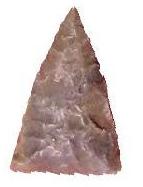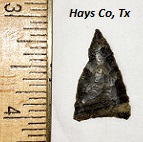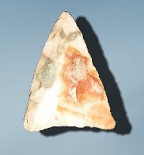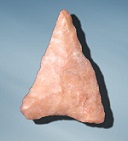Outline is Representative of Size and Shape:

Name Details:
Identified By: J. Charles Kelly
Named For:
Date Identified: 1947
Type Site: Lehmann Rock Shelter, Texas
Identified By: J. Charles Kelly
Named For:
Date Identified: 1947
Type Site: Lehmann Rock Shelter, Texas
Point Validity:
Valid type
Kelley was a distinguished anthropologist who served as Curator of the Archaeological Museum at the University of Texas-Austin and was instrumental in setting up the Department of Anthropology at the University of Texas-Austin. He specialized in the archaeology of western Texas. This type was named in a professional publication and has many professional references. This is considered a valid type.
Kelley was a distinguished anthropologist who served as Curator of the Archaeological Museum at the University of Texas-Austin and was instrumental in setting up the Department of Anthropology at the University of Texas-Austin. He specialized in the archaeology of western Texas. This type was named in a professional publication and has many professional references. This is considered a valid type.
Fresno Triangle
AKA: Kobs Triangular (Wheat, 1953) El Muerto (Taylor, 1966)
Cluster: Late Southern Triangle Cluster
Description of Physical Characteristics and Flaking Pattern:
This is a small thin triangular point with a flattened cross section. The blade is primarily straight, but may be seen with an excurvate or even less frequently, an incurvate blade. Rarely serrated, but may have deep serrations. The point primarily forms an isosceles triangle (half as wide as the height), or less frequently form an equilateral triangle (as wide as the height). The base is primarily straight to slightly concave and commonly has basal thinning. This point is commonly crudely made with the many examples having the smooth fracture scar of the flake covering the face instead of flaking across the face caused by removing flakes from the edge. This point is commonly made from a flake using pressure flaking forming a random flaking pattern.
Size Measurements:
Total Length - 20 to 35 mm, Width - 10 to 20 mm, Thickness - 2 to 6 mm.
Total Length - 20 to 35 mm, Width - 10 to 20 mm, Thickness - 2 to 6 mm.
Commonly Utilized Material:
Additional Comments:
This point was first described by Alex Krieger in 1946 based on examples found at the Harrell Site in Young County, Texas. This point was named by J Kelly for examples from the Lehmann Rock Shelter. Similar points were named Kobs Triangular by Jon Ben Wheat in 1953 for examples found while conducting the Addicks Dam Survey in Texas. W. W. Taylor (1966) used the name El Muerto points. Suhm and Krieger have included all these types into the Fresno type.
Points found in northeastern Texas should be considered for the Turney type. Higher quality points from northeastern Texas and into Oklahoma, Arkansas, and Louisiana may be Talco points. Deeply concave points could be considered Starr points (Suhm and Krieger, 1954).
This type is similar to the Cameron point, but is slightly smaller. The Cameron point is never longer than 17 mm in length while the Fresno is not less than 20 mm in length (Moore, 2015).
Hester (1969) studies a sample of 36 samples of Fresno / Cameron points and noted no “consistent morphological patterns” in the entire sample. Therefore, he classified those specimens that were less than 20 mm in length as Cameron and samples greater than 20 mm as Fresno. Hester believes that it is possible that both of these arbitrary groups are the same type.
This point was first described by Alex Krieger in 1946 based on examples found at the Harrell Site in Young County, Texas. This point was named by J Kelly for examples from the Lehmann Rock Shelter. Similar points were named Kobs Triangular by Jon Ben Wheat in 1953 for examples found while conducting the Addicks Dam Survey in Texas. W. W. Taylor (1966) used the name El Muerto points. Suhm and Krieger have included all these types into the Fresno type.
Points found in northeastern Texas should be considered for the Turney type. Higher quality points from northeastern Texas and into Oklahoma, Arkansas, and Louisiana may be Talco points. Deeply concave points could be considered Starr points (Suhm and Krieger, 1954).
This type is similar to the Cameron point, but is slightly smaller. The Cameron point is never longer than 17 mm in length while the Fresno is not less than 20 mm in length (Moore, 2015).
Hester (1969) studies a sample of 36 samples of Fresno / Cameron points and noted no “consistent morphological patterns” in the entire sample. Therefore, he classified those specimens that were less than 20 mm in length as Cameron and samples greater than 20 mm as Fresno. Hester believes that it is possible that both of these arbitrary groups are the same type.
Distribution: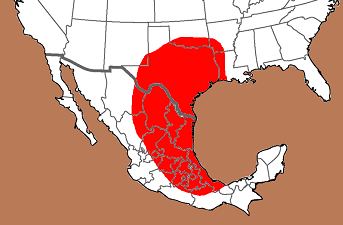

Distribution Comments:
This point is most commonly found in southern Texas, and into Chihuahua, Coahuila, Nuevo Leon, and Tamaulipas, and into central Texas. Has been rarely reported into eastern Texas and western Louisiana as well as the Red River valley. Has been reported into the Tehuacan Valley, Cueva de la Nopalera, Hidalgo, Mexico. Found throughout the Valley of Mexico.
This point is most commonly found in southern Texas, and into Chihuahua, Coahuila, Nuevo Leon, and Tamaulipas, and into central Texas. Has been rarely reported into eastern Texas and western Louisiana as well as the Red River valley. Has been reported into the Tehuacan Valley, Cueva de la Nopalera, Hidalgo, Mexico. Found throughout the Valley of Mexico.
Age / Periods:
Date: 1,200 - 250 B.P.
Cultural Period: Mississippian to Historic
Glacial Period: Vandal Minimum to Little Ice Age
Culture:
Date: 1,200 - 250 B.P.
Cultural Period: Mississippian to Historic
Glacial Period: Vandal Minimum to Little Ice Age
Culture:
Age Details:
This type is associated with a multitude aspects and foci including the Bravo Valley Aspect; Central Texas Aspect; Brownsville, Galveston Bay, Henrietta, Mier, Rockport, and Wyle foci as well as other foci in the Historic Stage (Suhm et al, 1954).
This type is associated with a multitude aspects and foci including the Bravo Valley Aspect; Central Texas Aspect; Brownsville, Galveston Bay, Henrietta, Mier, Rockport, and Wyle foci as well as other foci in the Historic Stage (Suhm et al, 1954).
Similar Points:
Cameron, Camp Creek, Cottonwood, Guerrero, Sand Mountain, Starr, Talco, Tortugas, Turney
Cameron, Camp Creek, Cottonwood, Guerrero, Sand Mountain, Starr, Talco, Tortugas, Turney
Other points in this cluster / Related / Associated Points:
Hamilton Triangle, Fort Ancient, Madison, Maud, Levanna, Uwharrie, Yadkin
Hamilton Triangle, Fort Ancient, Madison, Maud, Levanna, Uwharrie, Yadkin




